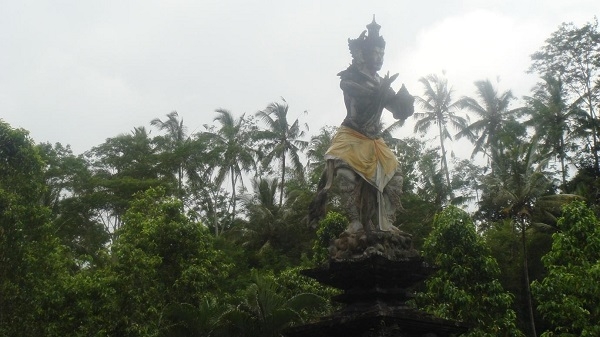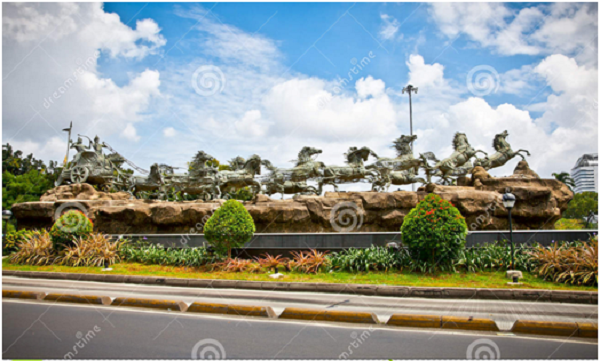Cultural Orphans: Indians Ashamed of their Own Heritage
14 Jul 2020 13:45:14
For an Indian, a visit to Indonesia can be an eye-opener. It is fervently proud of its heritage. Although it is the largest Muslim country in the world, it has inscribed the picture of Lord Ganesh on its 20,000 rupiah currency notes. Even the most prestigious institute of technology has Lord Ganesh in its logo. Indonesia’s official airline is called Garuda (Lord Vishnu’s mount) and the official bank is named after Kubera (the Hindu god of wealth).
Indonesian government patronises and supports dance dramas and puppet shows that depict stories of Ramayana and Mahabharata. It has also issued many stamps on the two epics. Jakarta has a huge sculpture of Lord Krishna revealing Bhagavad Gita to Arjuna. In Bali, statues of Hindu deities adorn most public places. Several cross-roads have massive sculptures portraying scenes from Hindu scriptures, like the sun-god riding his chariot, yoked by seven horses.

Statue of Hindu Deity in a Public Park in Bali
For an Indian, it is a puzzling experience: a Muslim country honouring Hindu gods. Unable to control his curiosity, a tourist quizzed our guide Mustafa. After looking at the perplexed faces of the group, Mustafa responded, “Earlier all of us were Hindus and worshipped these gods. Whatever be the reasons, we converted to Islam. I do not pray to these gods but respect them because I know that my parents, grand-parents and ancestors worshipped them? They are a part of my heritage and ancestry. Should change of faith make me disown my heritage? That would amount to my disowning my own lineage and ancestors.” The silence was deafening.
In a few sentences, Mustafa had taught us what we Indians have not learnt for centuries. No educated Indian ever boasts of India’s rich heritage. Our education system has ingrained in us an acute sense of inferiority. We eulogise everything that is Western and run down our own glorious past. Everything concerning ancient India’s intellectual prowess, cultural richness, multiple philosophies and liberal thoughts is painted as narrow-mindedness.

Sculpture of Lord Krishna and Arjuna in a Chariot at a Cross Road in Bali
India is perhaps the only country in the world that is ashamed of its heritage. Yes, the word ashamed is an apt description. Expressions like Vedas, Hindus, Hindutva, Saffron and Bharat Mata have come to convey a sense of inadequacy. The whole world applauds India for its Vedic knowledge, philosophical expositions, ayurveda, yoga and a host of other gifts to humanity. However, our Westernised stooges carry on deriding our heritage. Using Mustafa’s taxonomy, they take pride in masquerading as ‘cultural orphans’. Let me cite two events of the recent past to prove the above assertion.
The World Yoga Day
On 27 September 2014, Prime Minister Modi exhorted the UN General Assembly, “Yoga is an invaluable gift of India’s ancient tradition. It embodies unity of mind and body; thought and action; restraint and fulfilment; harmony between man and nature; a holistic approach to health and well-being.” He suggested that 21 June be adopted as the World Yoga Day. In less than 90 days, the UN General Assembly passed the resolution unanimously, accepting the fact that yoga originated in India around 5,000 years ago and is an immensely beneficial mental, physical and spiritual practice.
It was a recognition of India’s heritage and a matter of great pride for the Indians. While the intelligentsia ignored the feat, no channel ran prime-time programme to highlight the achievement. For them, anything belonging to ancient India cannot be acclaim-worthy.
At the first official observation of the World Yoga Day on 21 June 2015, a total of 35,985 participants from 84 nationalities performed asanas. Modi’s words, on the said occasion, were truly sagacious, “India’s priceless legacy is today world’s legacy.”
As is the wont of our India-deprecating critics, no one had a good word to say about the event. They faulted Modi for not doing asanas in the proper manner. Some even doubted his claims of doing yoga regularly. A significant segment appeared to be more obsessed with the spreading of yoga mats rather than the import of the occasion. Deviously, a campaign was started that the soldiers were demeaned as they were forced to lay mats whereas the fact is that the mats were laid by civilian workers and the army had provided a few Havildars to oversee layout and alignment.
An occasion of national pride was deliberately portrayed as a fundamentalist and anti-secular agenda of the ruling party. Baba Ramdev’s laudable offer of training yoga teachers for the army has also been termed as a step towards communalisation of the army. One wonders as to how Indians can revel in degrading India.
The Art of Living’s World Cultural Festival
In March 2016, nearly four lakh people from 155 countries attended anniversary celebrations of The Art of Living (AoL) at Delhi. It was described as ‘an impeccable choreography of spiritual exuberance’. Over 37,000 artists from around the world performed. The programme was beamed live to millions across the globe. The whole world admired it but not the self-proclaimed conscience-keepers of India.
They faulted the function for likely adverse ecological effect on the flood plains of River Yamuna. It was a laughable objection. Even a casual visitor can notice the appalling state of the flood plains due to rampant encroachments, regular dumping of garbage/debris and total neglect by the authorities. No environmentalist or social activist ever raised hue and cry to force the government to act.
On learning of AoL function, they suddenly rediscovered their long-forgotten concern for the flood plains and launched a sadistic campaign against the organisers. As was to be expected, media found a convenient issue to embarrass the government and dent India’s image. It was unfortunate that our President was advised to skip the function.
Despite repeated assurances and guarantees by the organisers that they would neither do any digging nor use any concrete, every effort was made to scuttle the initiative. As was to be expected, no channel has reported the fact that AoL has left the flood plains in much better condition than they were earlier.
The second objection was regarding the alleged use of military bridging equipment for a private function. It was conveniently forgotten that law and order and traffic management always remain a state responsibility, more so as a large number of foreign dignitaries were attending the programme. Aid to the civil authority in preventing likely stampede cannot be faulted. Every Kumbh Mela sees such bridges.
As regards the bridging equipment; launching and de-launching of equipment bridges is regularly practised by the Engineers. Hence, the opportunity was used to train as well. Interestingly, the army had built a similar pontoon bridge at Agra for a musical concert by Yani in 2006. No questions were raised then. Apparently, army bridges are fine for foreign performers but not for displaying Indian heritage.
Of Cultural Icons
While one may not agree with all the statements made by Baba Ramdev, it cannot be denied that he and Sri Sri Ravi Shankar have done India proud by showcasing richness of India’s ancient civilization on the world stage. They are India’s cultural ambassadors and national icons, far greater than many Bharat Ratnas of dubious distinction.
Baba Ramdev has taken yoga to the masses and made the world aware of its mental, physical and intellectual benefits for overall well-being. It is practised by the people of more than 170 countries now. Even the UN has been forced to accept that the benefits of yoga are ‘amazing’ and ‘holistic’. It is a monumental achievement.
Sri Sri has made AoL a household initiative in most countries of the world. More than 370 million people swear by it and practice regularly. One cannot think of another Indian who has spread the message of ancient India’s vedic knowledge as worldwide. Even the UN and the World Health Organisation have recognised that AoL enriches life and promotes wellness through spiritual growth and self-development.
However, as is the wont of many opponents of India’s ancient heritage, they abhor anyone taking pride in it. To deride own culture has been the hallmark of India’s intelligentsia. Modi was right in questioning the opponents, “If we keep criticising ourselves, why would the world look at us?”
And, the parting shot
Reverting to Mustafa, while taking leave of us at the end of the visit, his parting shot was, “India has such a rich heritage. Which country can boast of an ancient civilization, and 10,000 years of recorded history? Which country can claim to be the birth place of so many major religions and philosophies?”
“Your heritage consists of Vedic scriptures, Jainism’s Namokar Mantra, Lord Buddha’s teachings and Guru Nanak’s divinity. It is common to all Indians. No one can claim exclusive right over it and no one can disown it either. Can ancestry be disputed or renounced? The people who disown their heritage become culturally bankrupt,” he added.
We were dumbstruck. Mustafa had shamed us with his simple reasoning. By the time we regained our composure, he had boarded a bus to head for his next engagement, perhaps to enlighten another set of ignorant Indian tourists!